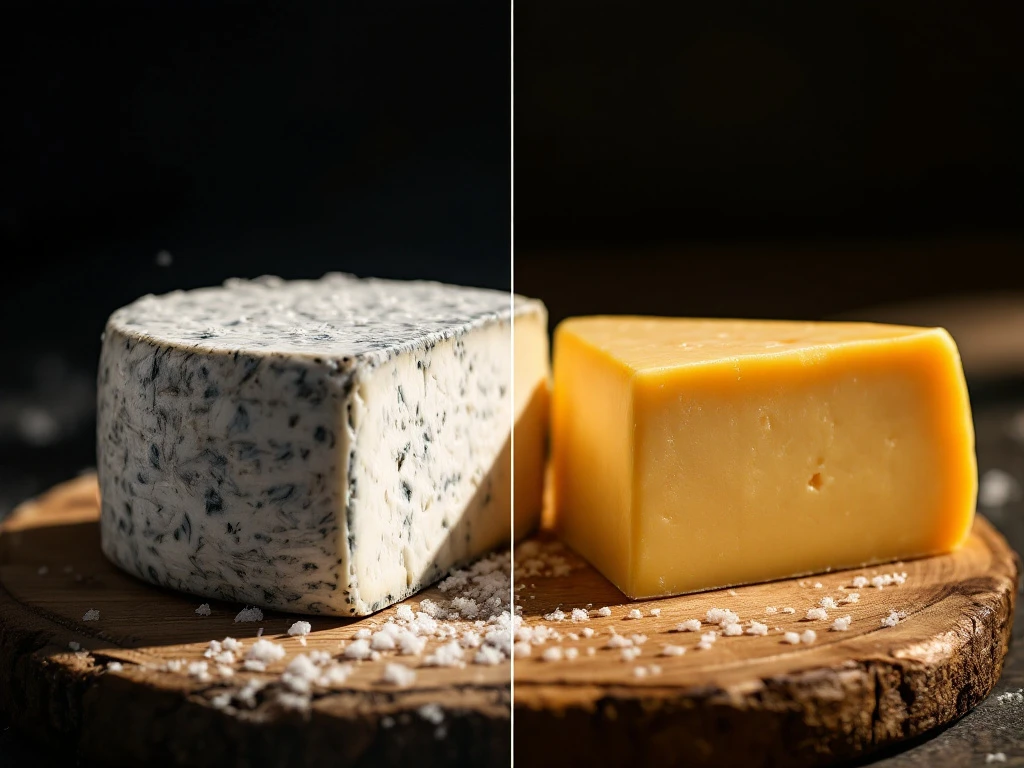Goat cheese usually has the same or slightly less salt than cow cheese. Fresh goat cheese has about 200-400mg of salt per 100g, while cow cheese has 300-600mg. Many people think goat cheese tastes saltier because of its tangy flavor. The natural sour taste in goat cheese makes people think it is saltier than it really is.
Is goat cheese actually saltier than cow cheese?
Fresh goat cheese usually has 200-400mg of salt per 100g. Similar cow milk cheeses have 300-600mg. The amount of salt depends more on how the cheese is made than on what type of milk is used. Fresh cheeses usually have less salt than old cheeses.
People think goat cheese is saltier because of its tangy taste. This special flavor comes from the goat milk itself, not from added salt. When you compare similar cheese types, like fresh goat cheese and fresh cow milk ricotta, they have almost the same amount of salt.
Old goat cheeses can have more salt, about 600-900mg per 100g. But this is the same as old cow milk cheeses like cheddar or parmesan. Making old cheese needs salt to keep it fresh, no matter if it comes from goat or cow milk. How the cheese is made and how long it ages affects salt content more than the type of milk used.
What makes goat cheese taste different from cow cheese?
Goat milk has special fatty acids that make its tangy flavor. These are called capric, caprylic, and caproic acids. Goat milk has much more of these acids than cow milk. This gives goat cheese its special taste that many people think is saltiness. The fat pieces in goat milk are smaller, which also changes the texture and taste.
The protein in goat milk is different from cow milk. This affects how the cheese is made. Goat milk has less alpha-s1 casein protein, so fresh goat cheese is softer and breaks apart easily. This difference means flavors come out differently when you eat it, making the tangy taste stronger.
Our traditional way of making goat cheese keeps these natural flavors while creating a good taste. Because goat milk is different, goat cheese naturally has a brighter, stronger flavor even when it has the same amount of salt as cow cheese. Understanding these natural differences helps explain why goat cheese tastes more complex without having more salt.
How does salt content vary between different cheese types?
Fresh cheeses have the least salt. Both goat and cow fresh cheeses have about 200-400mg per 100g. Soft cheeses like brie have medium amounts around 500-700mg. Semi-hard cheeses have 600-800mg. Hard old cheeses have the most salt, often more than 1000mg per 100g, no matter what milk is used.
How cheese is made greatly affects how much salt it has. Some cheeses sit in salt water, while others have salt rubbed on them. How long this takes and how much salt is used matters more than whether the cheese comes from goat or cow milk.
We make fresh goat cheese spreads with as little salt as possible, so that they are suitable for people who want to eat less salt.Making special aged cheeses needs careful salt use to get the right texture and flavor. Some ways of making cheese, like fresh cheese crumbles, use less salt but still taste good and stay fresh longer.
Why do some goat cheeses taste saltier even with similar sodium levels?
Texture is important for how salty cheese tastes. Crumbly goat cheese releases flavors faster than thick cow cheese. Goat cheese is more acidic (pH 4.5-5.0) than cow cheese (pH 5.0-5.5). This makes salt taste stronger on your tongue, even when there is the same amount of salt.
How much water is in cheese affects how salty it tastes. Fresh goat cheese often has more water than old cheese, which makes the salt stronger in what is left. When cheese melts in your mouth, how fast the salt comes out depends on fat and protein, which are different in goat and cow milk cheeses.
The mix of more acid, different fat, and special protein structure makes goat cheese taste saltier. Temperature also matters – goat cheese at room temperature has stronger flavors than when it is cold. This might explain why the same cheese can taste saltier in different situations.
Which cheese should you choose for a low-sodium diet?
Fresh goat cheese and fresh cow milk cheeses like ricotta or cottage cheese have the least salt, usually 200-300mg per 100g. Spreadable types often have less salt but still taste good because of the natural milk flavors. Young cheeses are better choices than old ones for people who want less salt.
Reading labels carefully shows big differences between cheese types. Some fresh goat cheese has as little as 150mg salt per serving, while some old cow cheeses can have more than 800mg. Look for words like “reduced sodium” or “lightly salted” on packages, but these cheeses might not stay fresh as long because salt helps preserve food.
For people who want good flavor with less salt, try using smaller amounts of strong-tasting cheese. A little bit of tangy goat cheese can give more flavor than a lot of mild cow cheese, which might mean eating less salt overall. We make different fresh goat cheese products, including spreads and crumbles, that taste great with medium salt levels. These are perfect for health-conscious people who still want good flavor.
